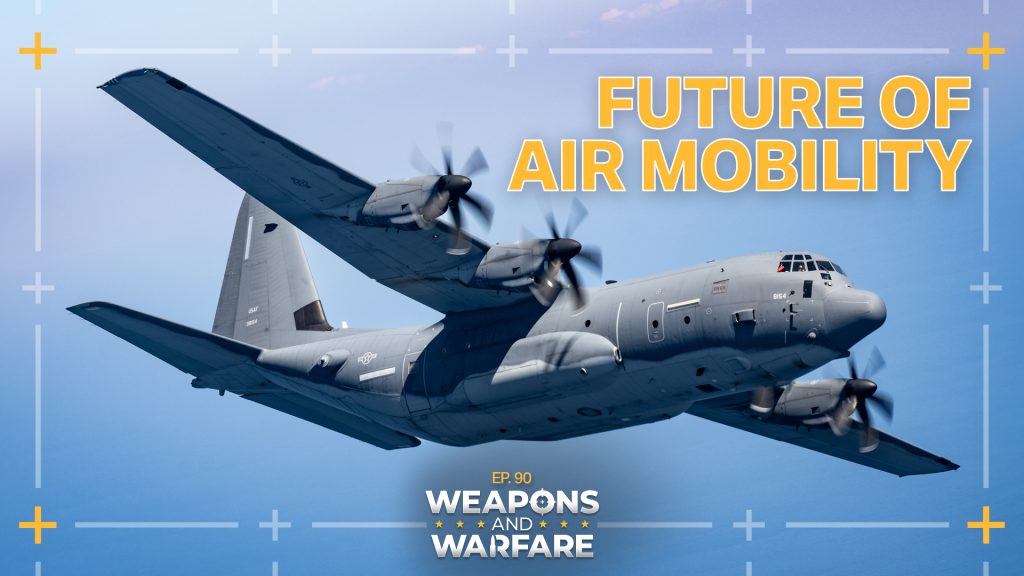AMC leaders push innovation as Ukrainian drone company pushes limits

This week on Weapons and Warfare, host Ryan Robertson takes part in a roundtable interview with Gen. John Lamontagnethe, commander of Air Mobility Command (AMC), on the future of AMC. Together, they’ll discuss the critical capabilities needed to navigate the complexities of modern warfare.
Lamontagnethe also shares insights on the strategic challenges AMC faces and the innovative technologies that will redefine air mobility in upcoming conflicts.
Gen. John Lamontagne, commander of Air Mobility Command (AMC), outlined his vision for the future of the Air Force’s mobility fleet during a roundtable with reporters at the Air, Space & Cyber Conference 2025. He emphasized the need to prepare for higher-threat environments and modernize aging aircraft while navigating budget constraints and evolving global challenges.
Lamontagne, who assumed command of AMC just over a year ago, said recent operations in the Middle East demonstrated the command’s capabilities but warned that future missions would demand more.
“If you look at what we just did, whether it was facilitating the B-2s going out to Yemen, or the B-2s hitting Iran — a relatively safe environment, all things being equal — that is not what we are going to be expected to do in the future,” Lamontagne said. “We have to be able to go into much higher threat environments.”
AMC oversees nearly 600 aircraft tasked with airlift and aerial refueling missions. Lamontagne said he wants the command to transition smoothly from legacy platforms, such as the C-5 and C-17, to next-generation heavy lifters.
“The C-17 and C-5 have served us well for decades, but they are not going to fly forever,” he said. “We would like to recapitalize those on our timeline. We have a competition already underway, with source selection driving toward a mid-2040s timeline. It is basically a two-for-one to replace both the C-17 and the C-5.”

Lamontagne said the new airlifter must be tactically agile, easier to maintain and equipped with advanced defensive systems. He stressed the importance of minimizing time on the ground, especially during refueling operations.
“We are obviously at a lot of risk sitting on the ground somewhere,” he said. “Three minutes would be better than 30 minutes.”
In July, Air Force Chief of Staff Gen. David Allvin announced plans to purchase 75 additional KC-46 Pegasus aerial refuelers from Boeing, eliminating the need for a temporary “bridge” tanker to replace the aging KC-135 fleet. Lamontagne said the Stratotanker would remain in service for decades.

“We will be flying the KC-135 into the 2050s,” he said. “That is a long time to maintain a legacy platform. Of course, it is not the same KC-135 that came into the inventory in the 1950s, and we do not want it to be the same platform in the 2050s or 2060s.”
Allvin reinforced the urgency of modernization in his keynote address.
“Our mission says ‘Fly, fight and win. Air power, anytime, anywhere,’” Allvin said. “We have to move at the pace to win. If we are not getting there, then we need to find another gear.”
Lamontagne said AMC must overcome two major hurdles to meet that pace: integrating advanced sensors to operate in contested environments and developing defensive capabilities to protect crews.
“The first step is being able to sense and make sense of the environment,” he said. “If you cannot make sense of the threat environment, you have no chance. That is what we are trying to do on connectivity, and that funding is starting to flow. The next step is having defensive systems or the ability to actually defend the team.”
He said AMC is exploring both external support, such as fighter escorts, and onboard solutions that would allow crews to defend themselves.
“We are trying to get to a place where we do not need somebody else to do it for us,” Lamontagne said. “We can bring a lot more capability to the joint force in a much deeper threat environment.”
Revolutionizing warfare with fiber optic bomber drones: Weapon of the Week
Unmanned aerial vehicles have reshaped modern warfare. Now, Ukraine is pushing the next evolution — unmanned bombers.
This week’s weapon of the week comes from JET, a Ukrainian drone company developing battlefield-ready systems with expanded payload capabilities.

JET’s newest platform is a bomber drone built entirely in-house. It carries up to 20 kilograms of payload and flies up to 60 kilometers without cargo. With a full load, it can complete a 15-kilometer round trip.
“It’s reliable and well-used on the battlefield,” said Danylo Pavlichenko, sales manager at JET. “It’s a game changer.”
The drone operates via remote control and requires two operators. It uses ground control stations with signal link modules for secure communication.
“There’s no AI component,” Pavlichenko said. “It’s fully controlled by our team.”
JET also showcased several FPV drones, including one equipped with a fiber optic cable. Fiber optic systems are unjammable, making them ideal for electronic warfare environments.
“Fiber optic is everywhere on the battlefield,” Pavlichenko said. “It’s the future of drone communication.”
JET’s fiber-equipped drones fly up to 20 kilometers. The company is developing longer-range models, including the Jet 10 LR, which can travel 40 kilometers and carry a 1-kilogram payload.
While JET continues to expand its product line, it already works directly with Ukrainian military units and defense organizations.
“We’re here to show our work, build relationships, and grow,” Pavlichenko said. “We want to put down roots in new places.”
As Ukraine adapts to evolving threats, companies like JET are helping shape the future of drone warfare — one payload at a time.
You can subscribe to the Weapons and Warfare podcast on the platform of your choosing here.
The post AMC leaders push innovation as Ukrainian drone company pushes limits appeared first on Straight Arrow News.





